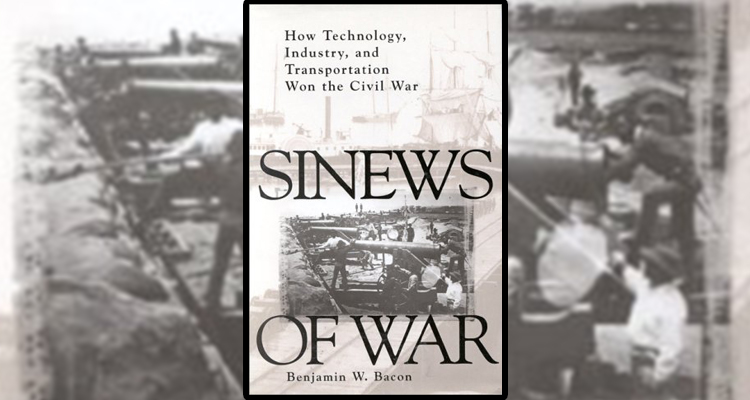Sinews of War: How Technology, Industry, and Transportation Won the Civil War, by Benjamin W. Bacon, Presidio Press, Novato, California, (415) 898-1081, 288 pages, $24.95.
This book has a hopeful title. In assessing the Civil War, sometimes too much attention is focused on the Lees, the Grants, the Gettysburgs, and the Vicksburgs without due consideration going to the industrial foundations of Northern and Southern societies. It was industrial, technological, and transportational might that rendered so much consistent Confederate success in the Eastern theater ultimately irrelevant. Union skill on the battlefield had less to do with victory than did the massive application of technology and industry far from the battle front. The title of this book suggests, and indeed the dust-jacket blurb asserts, that this would be a fresh look at the unseen yet decisive side of the war. The title, however, is misleading. And the result is disappointing.
The first hint of trouble comes in the introduction, where the author–a descendant of Connecticut’s war governor and a relation of that state’s wartime quartermaster general–warmly declares that the book is “a tribute to the new technology of the nineteenth century and how it was put into service to win the war.” We are awash with Civil War books designed as tributes, written by descendants or fans to document and rehabilitate the reputation of a regiment or commander. The good news is that this book, though sentimental in its approach, does not live up to its claimed status as a “tribute.”
The bad news is that it tells us nothing new, and does little to justify its hopeful title. This meandering narrative of the war tracks not those events or trends that might tell us something important about the relationship of technology, industry, and the Union war effort, but those events that the author found most interesting (or perhaps those readily available in sources at his local library). Industry and technology are merely an intermittent subtheme. The book uses the chronology of military campaigns as the foundation for its story. Yet, it meanders, often inexplicably, to topics unrelated. Perhaps forty percent of the book has anything at all to do with its title.
Outstanding work in history requires mastery of three disciplines: research, analysis, and expression (writing, in this case). Rare is the work that achieves proficiency in all three areas. Rare, too, is the work that fails in all three (amid today’s flood of Civil War books, most authors can at least lay claim to one strength, usually strong research). This book, unfortunately, fails in all three.
The author and publisher assert up front, and properly so, that this is a book designed for popular consumption. That, however, ought not to be license for superficial research. The bibliography includes only a single primary source (John Billings’s overused Hardtack and Coffee, which, of course, has little to tell us about technology and industry), and a small group of secondary sources that can be found in any mid-sized library in the country. Not a single source on Northern industry or technology is cited. Nothing on the Northern economy, labor, or agriculture was used.
So much could have been used to enrich the work, and so very easily. The countless inexcusable errors that pock this book suggest the author’s lack of command over his subject matter. The cumulative effect is devastating–shattering the reader’s confidence in the author’s ability to properly tell the story. Equally damaging are the unsubstantiated generalizations, speculation, and self-assured opinions that dot the narrative, such as the Confederate cavalry “was far superior” to Union cavalry and “…Beaten Civil War opponents had a tendency not to stay beaten.”
Bacon speculates that Union General-in-Chief Henry Halleck conspired to sabotage Burnside’s crossing at Fredericksburg by withholding the pontoons. He also opines that “Better generalship by the South would have increased casualties.” If McClellan had “been enabled to fill a position as head of training command of the U.S. Army…he would today be remembered as one of the great architects of Union victory.” And the last example: “…who can say how the modern South would have developed if at least some black and white Confederates could have experienced a sense of comradeship….” Perhaps from a Freeman, Nevins, or McPherson, such personal opinions and speculations might be appropriate and provocative. But from Freeman, Nevins, or McPherson, such opinions would be borne of the considered evaluation a mass of source material. Not so in this case.
Bacon simply does not make the connections or offer the analysis one expects from a book of this sort. He makes no mention, for example, of the exciting innovations developed by industrialists like Henry Burden–who produced horseshoes by the thousands every day–and who materially affected the outcome of the war. To Bacon, technology and industry mean railroads, pontoons, and steamboats serving the theater of war. The larger, more important story of a nation mobilizing its every social and economic fiber for victory goes untold.
Sometimes artful writing can obscure, or distract from, mediocre research or analysis. The writing here does not. Clich?s abound. Passive constructions permeate the entire narrative. Clunky sentences are common. The writing fails to elevate the book beyond the standard established by the research and analysis.
This is a fine-looking book from a well-known press. Its substance, however, does not sustain its appearance. Even the most general of Civil War readers would be well-advised to look elsewhere to learn how technology, industry, and transportation won the Civil War.
John Hennessy
Fredericksburg, Virginia





